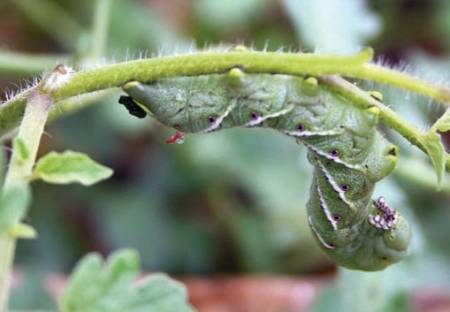Hornworms on Tomatoes

Anyone who has gardened for several years has heard of hornworms on tomatoes. These caterpillars are the larval form of sphinx moths and belong to the Sphingidae family. In Kansas, two hornworms can cause problems with tomatoes: the tomato and tobacco hornworms. Tomato hornworms come in shades of green with eight yellow chevrons and a black tail. At the same time, the adults have five yellow spots on their abdomen and distinct wavy lines on their wings; the tobacco hornworm is various shades of green with seven diagonal stripes and a red tail (see photo above). In contrast, the moth has six yellow spots on their abdomen and obscured wavy lines on their wings.
There are two generations of these moths in Kansas throughout the summer, with the insects overwintering as a pupa in the soil. The adults emerge in mid-June and start to lay eggs soon after. The preferred food sources include potatoes, eggplant, tomatoes, and moonflowers. The larvae will feed for 30-50 days before pupating to become adults. The larvae have voracious appetites, and plants with multiple caterpillars can be defoliated almost overnight. Because of their color, spotting the plants as they blend in with the leaves can be tough. The best control is monitoring your plants, removing any leaves with eggs, and removing the caterpillars once you first notice damage. Insecticides are rarely needed as the caterpillars can be hand-picked off the plants and killed. Several natural predators parasitize the caterpillars and kill them before they cause too much damage.

Have questions? Contact our office where our Horticulture Extension Agent will assist you with questions.
Phone: (316) 321-9660
Email: callae@ksu.edu